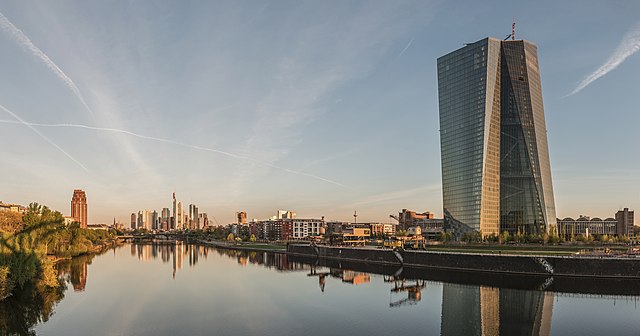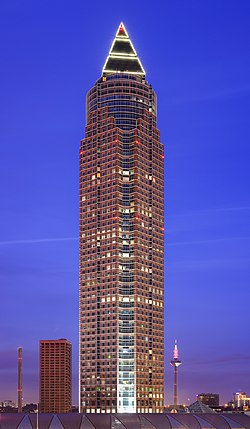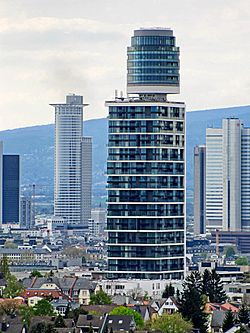Top Qs
Timeline
Chat
Perspective
List of tallest buildings in Frankfurt
From Wikipedia, the free encyclopedia
Remove ads
Frankfurt is the most populous city in the German state of Hesse. Sitting at the heart of the Rhine-Main metropolitan region, which has a population of over 5.9 million, Frankfurt is considered the financial capital of Germany. Frankfurt is one of the few European cities with a sizeable concentration of tall buildings in its city centre. The city is often referred to as "Mainhattan", a portmanteau of Manhattan and the river of Main that runs through the city.[1][2][3] Frankfurt is home to the majority of Germany's skyscrapers, including its 15 tallest. Its skyline is one of the largest in the European Union, and by far the largest in Germany.

As of 2025, Frankfurt has 43 high-rises that reach a height of 100 metres (328 ft), 20 of which are taller than 150 m (492 ft). The tallest building in Frankfurt is the 56-storey Commerzbank Tower, which rises to a height of 259 m (850 ft) and was built in 1997.[4] It is the second tallest building in the European Union. Reflecting the city's role as a financial centre, it houses the headquarters of Commerzbank. However, the tallest free-standing structure in the city is the Europaturm, a 337 m (1,106 ft) tall telecommunication tower, located to the north of the skyline.
After undergoing extensive bombing during World War II, which destroyed Frankfurt's medieval city centre, the city mostly embraced modernist architecture during reconstruction. Frankfurt's high-rise boom began in earnest during the 1970s, and the construction of new skyscrapers has been steady since. Frankfurt has nearly doubled the size of its skyline in the 21st century, with 22 buildings taller than 100 m (328 ft) in 2000, compared to 43 today. A major addition in the 2020s is the mixed-use Four complex in 2025, consisting of four skyscrapers, the tallest of which is Frankfurt's third tallest building.[5]
Most of Frankfurt's high-rises are located in the central districts of Innenstadt, Westend-Süd, and Bahnhofsviertel, north of the Main river. They form an area commonly known as Bankenviertel (Banking Quarter), which has no exact borders. There are a few buildings taller than 100 m (328 ft) dispersed outside the area, the most notable of which is the headquarters of the European Central Bank, which sits on the Main to the east of the city centre.
Remove ads
History
Summarize
Perspective
Number of skyscrapers by height in Frankfurt at the end of each year. This takes into account AfE-Turm, which was demolished in 2014, as well as City Gate and Park Tower, two high-rises that were originally shorter than 100 m whose heights were increased after a renovation in 1993 and 2007 respectively. See or edit chart definition.

1940s–1960s
Frankfurt had a few buildings that could be considered high-rises before World War II, such as the IG Farben Building, Mousonturm, and the Gewerkschaftshaus, though none of them surpassed ten storeys. As one of Germany's largest cities, Frankfurt was extensively bombed by Allied forces throughout the war, mainly between 1940 and 1945, leading to the destruction of much of its city centre.[6][7] Reconstruction of the city took place from 1945, during which simpler buildings designed in the modernist style were preferred, as they were quicker to build.[8][9]
The first high-rises would only appear in the 1960s, however, the first building to surpass 50 m (164 ft) was the Zürich-Haus with a height of 68 meters (223 ft). It was built between 1958 and 1960 by Zürich Insurance based on designs by architects Udo von Schauroth and Werner Stücheli. Another one of the city's first high-rises, the Büro Center Nibelungenplatz (now City Gate), being built outside of the city centre, in the Nordend-West district, in 1966. The tower, originally built for Shell, was part of a development plan comprising the entire northern Alleenring, the ringroad surrounding Frankfurt.[10] However, while not an inhabitable building, the grain storage silo of Henninger Turm was completed earlier in 1961 at a height of 120 m (394 ft), with a circular observation tower.[11]
1970s–1980s

From the 1970s onward, high-rise development would mostly occur in the city centre, brought about by increasing demand for office space, and initially concentrated in the district of Westend. The area around these new skyscrapers would come to be known as Bankenviertel. The first building taller than 100 m (328 ft) in the city, AfE-Turm, was located there. Built in 1972, it formed part of the Bockenheim campus of the Johann Wolfgang Goethe University, and until 2013, housed the offices and seminar rooms of the departments of Social Sciences and Education. It was Frankfurt's tallest building for two years, being surpassed by City-Haus in 1974. The 142 m (466 ft) City-Haus was also known as "Selmi-Hochhaus" after the Persian builder Ali Selmi.[12][13]
The title of the tallest building in Frankfurt was broken two more times in the 1970s as building heights rose, first with Westend Gate in 1976, the first skyscraper to surpass 150 m (492 ft) in height. It, too, was only the tallest building for two years, as it was surpassed by the Silberturm (Silver Tower) in 1978. These new towers served as major financial headquarters in the 1970s, including Commerzbank, Dresdner Bank, DZ Bank. Southeast of the city centre in the Sachsenhausen district, the Leonardo Royal Hotel Frankfurt was completed in 1972.[14]
In 1974, construction began on the Europaturm ("Europe Tower") telecommunication tower, which was completed in 1979 north of the city centre.[15] At 338 m (1,107 ft), it was the tallest free-standing structure in West Germany; however, it was bested by the Fernsehturm Berlin, which is over 30 metres (98 ft) taller. Skyscraper construction slowed down slightly in the 1980s, as only four high-rises above 100 m (328 ft) were completed in that decade, compared to nine in the 1970s. The most signficant skyscrapers built in this period were the Deutsche Bank Twin Towers, built as the headquarters for Deutsche Bank. The trapezoidal towers feature a reflective glass facade.
1990s–2000s

The 1990s saw the addition of two major skyscrapers that form the two tallest icons in the skyline today. The first of these was Messeturm, completed in 1990 as the tallest building in Frankfurt, in Germany, and in all of Europe. Designed by German-American architect Helmut Jahn, the tower's postmodern form is a departure from the city's earlier skyscrapers. Its pointed design resembles the Bank of America Plaza in Atlanta and the Key Tower in Cleveland, both built around the same time. The second is Commerzbank Tower, designed by Foster & Partners as the new headquarters of Commerzbank, replacing the Global Tower built in 1973.
When Commerzbank was planned in the early 1990s, Frankfurt's Green Party, who governed the city together with the Social Democratic Party, encouraged Commerzbank to design a 'green' skyscraper. The result was the world's first so-called "ecological skyscraper": besides the use of 'sky-gardens', environmentally friendly technologies were employed to reduce energy required for heating and cooling.[16] Other major completions included the Westendstrasse 1, then the city's second-tallest building, in 1993, and Main Tower, then Frankfurt's fourth-tallest, in 1999. Both Main Tower and Commerzbank Tower feature antenna spires that increase the building's height significantly; in the case of Commerzbank Tower, the antenna gives the building the height of a supertall skyscraper, at 300.1 m (985 ft).
Development continued into the 2000s, with the tallest new developments remaining office towers. Building heights were somewhat shorter in this decade, with the tallest building completed being Opernturm at 170 m (558 ft). Westhafen Tower was completed in 2004 in the Westhafen area, on the northern bank of the river Main. Somewhat isolated from the main Bankenviertel cluster, it forms the peak of a small group of high-rises south of the main train station.
2010s–present

Frankfurt's building boom was mostly unaffected by the Great Recession, and an uptick in height took place in 2010s compared to the previous decade. Four skyscrapers taller than 150 m (492 ft) were completed in this decade, the tallest of which is Tower 185 in 2011. The second tallest was the new seat of the European Central Bank, completed in 2014. The central bank's previously resided in the Eurotower, which was built during the building boom of the 1970s. The building's history dates back to 2002 with the launch of a design competition.[17] The architectural concept of the building is a "monolithic block" divided by a "hyperbolic cut", and then further twisted and filled with glass atriums.[18] The tower stands alone from other high-rises, to the east of the skyscrapers in Bankenviertel, creating a "counterpoint" to the main skyline.[19]
The increasing demand for real estate, the exit of the United Kingdom from the European Union, and a favorable economic development in Germany led to a boom in high-rise construction from 2015 onwards. With the 180 m (591 ft) Grand Tower, Germany's tallest residential high-rise has been located in Frankfurt am Main since its completion in 2020.[20][21] After Brexit, Commerzbank Tower briefly regained the title of the tallest building in the European Union, which had been surpassed by The Shard in London in 2012. It would soon lose it again to Varso Tower in Warsaw in 2022, although Commerzbank Tower remains taller by roof height.
AfE-Turm, formerly Frankfurt's tallest building, was demolished in 2014, as the university's departments of Social Sciences and Education moved out in 2013. It was replaced with the Senckenberg-Quarter in 2023, including the One Forty West skyscraper.[22] One Forty West has a distinctive parametric facade on its upper floors,[23][24] reflecting a growth in skyscrapers with unique designs, such as the glass-clad Omniturm in 2020, with a notable "hip curve" halfway up the building.[25] The Henninger Turm grain silo was demolished in 2013, with a new 140 m (460 ft)-tall residential skyscraper built in its place. The tower, completed in 2017, deliberately evokes the shape of the old silo, making it one of Frankfurt's most distinctive buildings.[26]
In 2018, construction started on Four, a major mixed-use skyscraper project consisting of four towers, hence the name. The site was originally owned by Deutsche Bank, which commissioned a design competition for a new office tower, but plans were shelved in the 2000s, and the siste was sold to developer Groß & Partner. The towers sit on a shared podium, and feature vertical "kinks" that provide more sunlight on the lower floors.[27] The tallest of the buildings, Four I, is currently Frankfurts third tallest building.
Remove ads
Cityscape

Map of tallest buildings
Summarize
Perspective
This map displays the location of buildings taller than 100 m (328 ft) in Frankfurt. Each marker is coloured by the decade of the building's completion. There area a total of five high-rises taller than 100 m (328 ft) that are located outside the scope of the map: the Seat of the European Central Bank, Henninger Turm, Westhafen Tower, Büro Center Nibelungenplatz, and Leonardo Royal Hotel Frankfurt.
Buildings taller than 100 m (328 ft) in Frankfurt. An asterisk (*) next to the building's name indicates it is located outside the map.
- 1960s
- 1970s
- 1980s
- 1990s
- 2000s
- 2010s
- 2020s
1
Commerzbank Tower2
Messeturm3
Four I4
Westendstrasse 15
Main Tower6
Tower 1857
ONE8
Omniturm9
Trianon10
Seat of the ECB*11
Grand Tower12
Four II13
Opernturm14
Taunusturm15
Silberturm16
Westend Gate17
Deutsche Bank I18
Deutsche Bank II19
Marienturm20
Skyper21
Eurotower22
One Forty West23
Frankfurter Büro Center24
City-Haus25
Henninger Turm*26
Gallileo27
Nextower28
Pollux29
The Spin30
Four III31
Garden Tower32
Messe Torhaus33
Park Tower34
Japan Center35
Westhafen Tower*36
IBC Tower37
Büro Center Nibelungenplatz*38
Eurotheum39
WinX40
Global Tower41
Senckenberg Turm42
Four IV43
Leonardo Royal Hotel Frankfurt*Tallest buildings
Summarize
Perspective
This lists ranks the tallest buildings in Frankfurt that stand at least 100 metres (328 ft) tall as of 2025, based on standard height measurement. This includes spires and architectural details but does not include antenna masts. Only habitable building are ranked which excludes radio masts and towers, observation towers, steeples, chimneys and other tall architectural structures. These buildings are included for comparison. The “Year” column indicates the year of completion.
* Was the tallest building in Frankfurt upon completion
Remove ads
Tallest under construction or proposed
Summarize
Perspective
Under construction
The following table ranks high-rises under construction in Frankfurt that are expected to be at least 100 m (328 ft) tall as of 2025, based on standard height measurement. The “Year” column indicates the expected year of completion. Buildings that are on hold are not included.
Proposed
The following table ranks approved and proposed high-rises in Frankfurt that are expected to be at least 100 m (328 ft) tall as of 2025, based on standard height measurement. The “Year” column indicates the expected year of completion. A dash “–“ indicates information about the building’s height or year of completion is not available.
Remove ads
Tallest demolished
This table lists buildings in Frankfurt that were demolished or destroyed and at one time stood at least 100 metres (328 ft) in height.
Remove ads
Timeline of tallest buildings
This lists buildings that once held the title of tallest building in Frankfurt.
Remove ads
See also
References
External links
Wikiwand - on
Seamless Wikipedia browsing. On steroids.
Remove ads

















































